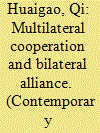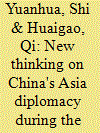| Srl | Item |
| 1 |
ID:
091933


|
|
|
|
|
| Publication |
2009.
|
| Summary/Abstract |
China's new thinking about neighboring diplomacy in Asia since the end of Cold war can be analyzed theoretically from angle of international institutions.China utilizes institutionalism with great flexibility in four sub-regions-Central Asia, Northeast Asia, Southeast Asia and South Asia, where institutional models-dominant participation, deep participation, active participation and moderate participation models have been adopted.
|
|
|
|
|
|
|
|
|
|
|
|
|
|
|
|
| 2 |
ID:
089248


|
|
|
| 3 |
ID:
099677


|
|
|
|
|
| Publication |
2010.
|
| Summary/Abstract |
Drawing support from international institution theory, this article analyzes China's new thinking about Asian diplomacy after the Cold War. Institutionalism was flexibly utilized by China in its peripheral regions-Central Asia, Northeast Asia, Southeast Asia and South Asia, which have adopted institutional models-dominant participation, deep participation, active participation, and moderate participation models. China tries to handle the presence of U.S. interests well and has responded reasonably to U.S. pragmatic institutional engagement. To realize the aim of compatibility and coexistence between China and the United States in Asia, the two countries should establish interconnecting institutions in both economic and political fields. With regard to the future interactive trends of China and the United States in Asia, the author, from the dimension of international institutionalism, works out an institutional interplay-nested and overlapping institutions-for China and the United States to achieve accommodation.
|
|
|
|
|
|
|
|
|
|
|
|
|
|
|
|